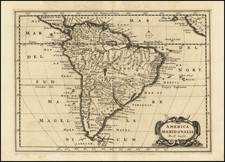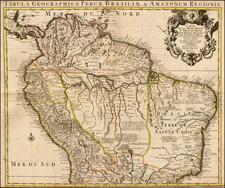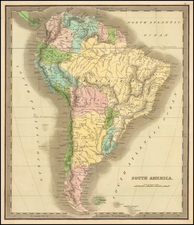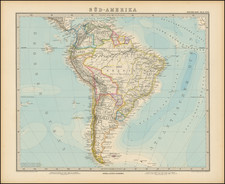Detailed copy plate engraving showing Commodore Byron's meeting with the supposed "giants" of Patagonia.
The legend of the strikingly tall Patagonians has its origins in Magellan's voyage in the 1520s. According to Pigafetta's account, Magellan encountered a race of giants whom he referred to as "Patagons" because of their large feet. Hence the southern tip of South America came to be known as Patagonia. Other 16th Century reports of the giant Patagonians came from Francis Fletcher, the chaplain serving with Sir Francis Drake, and from Anthonie Knivet, who had sailed with Sir Thomas Cavendish, who claimed to have seen dead bodies in Patagonia measuring 'over twelve feet in length'. In the early-eighteenth century Captains Harrington and Carmen in 1704 both corroborated the story.
The story gained popular currency after the return of Byron's ship Dolphin from her circumnavigation. While the ship lay in dock, a rumor leaked out that the crew had encountered a tribe of 'nine-foot giants' in Patagonia in 1764. The account of Byron's meeting with the giants first appeared in print in May 1766 in the Gentleman's Magazine, and was followed by other newspaper reports. Byron's own account, with its well-known engraved frontispiece of European officers standing waist-high to enormous Patagonians, was published in 1766. As Bernard Smith points out, Byron did not have the luxury of an artist on board the Dolphin to record this meeting. Instead it was left to an artist in London to furnish the illustration from Byron's description of events: 'one of them, who afterwards appeared to be a Chief, came towards me: he was of a gigantic stature, and seemed to realize the tales of monsters in a human shape…'.
Yet despite the presense of skilled artists and observers on the Endeavour voyage of 1764, which put the height of male Patagonians at between 'five feet eight inches to five feet ten inches', the myth persisted. This was in large part due to Hawkesworth's combined narrative of the voyages of Byron, Cook and others published in 1773, which concluded that the giants did indeed exist. An engraved plate depicting the "interview" with Byron shows the Patagonians towering head and shoulders above the Englishmen.
Alexander Hogg was a publisher active in London from 1778 to 1824. He worked under the sign of the Kings Arms on Paternoster Row. He is especially known for publishing architectural and historical prints, as well as maps.












![[ World & Continents ] Typus Orbis Terrarum / Americae Sive Novi Orbis Nova Descriptio / Asiae Nova Descriptio / Africae Tabula Nova / Europae](https://storage.googleapis.com/raremaps/img/small/99250.jpg)

